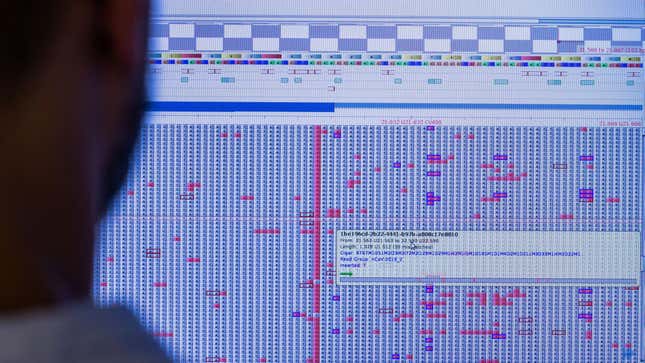
Imagine a future scenario in which a dangerous new virus is detected in chimpanzees. To prevent this virus from spreading to humans, biologists decide to deliberately infect scores of wild chimps with a transmissible vaccine—an infectious, lab-grown virus that immunizes, rather than harms, its host. The chimps, now vaccinated, no longer pose a threat to humans.
That solution sounds too good to be true, which is exactly the problem, as scientists warn in a new Policy Forum published today in Science. Self-spreading vaccines are potentially dangerous and difficult to manage, and are “genetically too unstable to be used safely and predictably outside contained facilities,” write the authors, led by Filippa Lentzos from King’s College London and Guy Reeves from the Max Planck Institute for Evolutionary Biology.
This is not just their opinion, the authors argue. Rather, it’s an “evidence-based norm” that’s been around for decades, but this “norm now seems to be challenged,” they write. The result is an increased potential for “risky research on lab-modified self-spreading viruses,” according to the report. This could lead to a normalization of the concept and eventual real-world use without the proper safeguards, the scientists argue.
“Self-spreading vaccine research continues to proceed despite a lack of new information that would compellingly refute long-standing evidence-based norms in virology, evolutionary biology, vaccine development, international law, public health, risk assessment, and other disciplines,” the biologists write.
Vaccines that spread like a disease are an unquestionably powerful concept. They could be used to protect animals from disease and/or prevent them from harboring viruses dangerous to humans. In 2020, biologists Scott Nuismer and James Bull, both at the University of Idaho, argued for this very approach in a paper titled “Self-disseminating vaccines to suppress zoonoses.” (By self-disseminating virus, scientists mean a virus that has been artificially modified to perform a desired function while retaining its ability to spread between hosts.)
By leveraging the spreading power of viruses, scientists could create biological agents that proliferate quickly through a target population, with the viruses performing specific tasks, such as delivering vaccines or sterilizing invasive species. In the late 1980s, Australian researchers dabbled with lab-modified, contagious viruses, using multiple approaches to exterminate foxes, mice, and rabbits, according to the paper.
More conceptually—and certainly more controversially—this strategy could also be used to spread vaccines among humans.
As the paper points out, interest in this biotechnology has increased significantly over the past several years, with the European Union (through its Horizon 2020 program), the U.S. National Institutes of Health, and the U.S. Defense Advanced Research Projects Agency all currently running programs to explore a wide range of possible applications.
Lentzos, Reeves, and colleagues say it’s time to pump the brakes and consider the consequences of this research and all the moving parts needed to make such a thing work. It’s not immediately clear, they argue, that self-disseminating viruses can be contained or removed from an environment once released, or who would be responsible for the biocontrol agent, should the virus behave unexpectedly or cross national boundaries.
Advocates of the idea say these viruses could be modified to have short lifespans or be made incapable of mutating, but “it remains to be experimentally tested if [manipulations] could simultaneously limit viral replication transmissibility to the extent that they could be perceived as controllable while maintaining sufficient transmissibility to be considered useful as vaccines in continually dynamic environments,” according to the report.
As for using transmissible vaccines to limit the spread of diseases from animals to humans, the scientists say the “the vast majority of virus species that currently exist are undescribed by science,” making it “very difficult to imagine how the considerable effort necessary to develop and test self-spreading vaccines could identify and then prioritize single viral species circulating in wildlife.” That viruses are constantly mutating makes this task all the more onerous, they add.
In terms of what’s needed, the authors call for various safeguards, cost-benefit analyses, and measures such as regulatory oversight. This would involve “a concerted, global governance effort with coherent regional, national, and local implementation.” The essay suggests that national governments update their legislation and guidelines on the matter, while developers and funders of this research “articulate comprehensive and credible regulatory paths through which they believe the safety and efficacy of self-spreading approaches could be established.”
In an email, Bull, co-author of the 2020 paper advocating for research into this biotechnology, said the authors of the new report “raise several valid points,” and he agrees that “informed regulatory oversight is essential,” adding that “public acceptance is also essential.”
“Until we undertake preliminary studies of transmissible vaccines (in contained environments), we will have little evidence on which to base estimated risks and benefits,” Bull told Gizmodo. “It is to be expected that early papers on transmissible vaccines explore the theoretical possibilities, many of which will never be practical or, as further work may show, never be safe.”
In an effort to move ahead cautiously, Bull recommended conservative approaches, such as creating a vaccine from a benign virus that already exists in a target population, as opposed to modifying an otherwise harmful virus. Work into gene drives, a related technology in which modified organisms engineer an entire species, could also help. “Just as gene drive developers have responded to regulatory concerns and have invented new designs with limited potential for spread, it is expected that investment in laboratory studies of transmissible vaccines will also lead to methods that mitigate risks,” Bull argued.
The idea of transmissible vaccines might die on the vine, whether on account of technical issues, safety concerns, or lack of public acceptance. But, clearly, dedicated research attention is needed, since the potential benefits—and risks—are immense.
More: Genetically Engineering Nature Will Be Way More Complicated Than We Thought